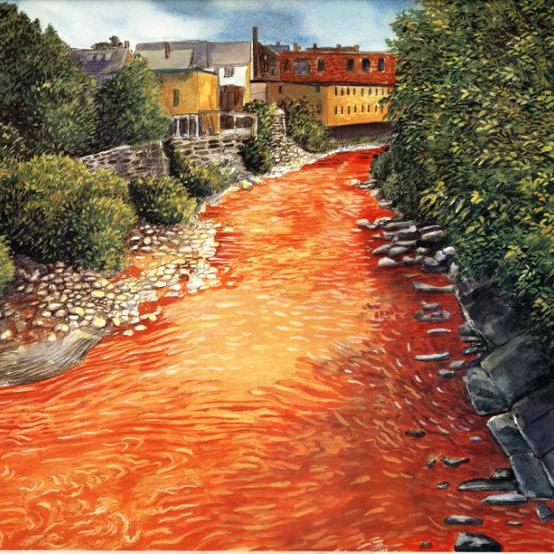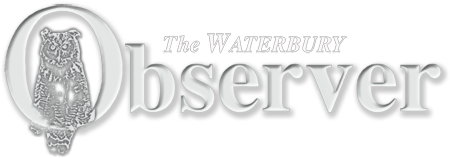The River
Column By John Murray

Colored dyes stained rivers throughout the industrial Northeast. By Lynn Cherry
It was the best day the Naugtauck River has experienced in 100 years. The river received so much attention on February 24th that one could imagine her embarrassed, and blushing red for old time sake. This blush, however, was triggered by admirers gushing at her beauty, not from the red dyes that were pumped into her as industrial waste into a glorified toilet.
Times have changed, and two events on February 24th showcased the shift.
First, a Naugatuck River Forum was staged inside the Mattatuck Museum that brought together developers, businessmen, political leaders, community activists, environmentalists and state and federal officials to discuss the future of the 39 mile long river.
It was an historic gathering, and the enthusiasm in the room bodes well for a river that has been abused, neglected and poisoned. If the river were human, the communities up and down the Naugatuck River would be in prison for murder.
This generation has a chance at redemption, and the gathering in the Mattatuck Museum signaled a collective will to seize that opportunity.
Hours after the river forum concluded, a small gathering took place inside the newly renovated Aldermanic chambers in downtown Waterbury that re enforced just how far the river has come. It was the monthly meeting of the Waterbury Greenway Committee and it was announced that a New York based company had been selected to design and oversee construction of the first phase of a 7.1 mile greenway project in the South End of Waterbury.
The company, RBA, has successfully completed the Brooklyn Greenway, the Manhattan Waterfront project, and the Hudson River Greenway. They have a world class track record of designing greenways, and the news electrified members of the Waterbury committee. After years of planning and routing studies, the greenway in Waterbury is one step closer to reality.
Ann Burton started the day off by addressing the 150 attendees of the Naugatuck River Forum with a short and eloquent talk. “The Naugatuck River has made the valley what it is,” Burton said. “It has given life to settlements, farms and factories. The river has created great prosperity for us and for the whole country.”

Illustration from “A River ran Wild” by Lynn Cherry
Burton is a member of the steering committee that planned the forum, and is heavily involved in an environmental committee of the Connecticut Community Foundation, which co-hosted the event with Rivers Alliance of CT. “The Naugatuck River has given us life,” Burton said, “and we’ve drained the life from it.”
Burton went on to describe the efforts of environmentalists to restore vitality to the river and said there is now, “life and animals back in the river. We are in the early stages of recovery, and we are gathered here today to find ways to work together to restore the Naugatuck River.”
Congressman Chris Murphy called the gathering a “who’s who of the past, present and future of the Naugatuck River.” Murphy went on to describe the damage inflicted on the river “a testament to what man can do to a river with dyes and toxins”, and the forum was “a testament to what man can do to undo that damage.”
Before the forum considered development and environmental issues, Laura Wildman, of Princeton Hydro, gave a concise and devastating history of the river. She described the Naugatuck River as an industrial sewer that changed colors every day, and was so toxic at one point that “the river caught on fire.”
From that horror Wildman now sees a river that will support wildlife, fish, inner tubing and kayaking. ‘We turned our backs to the Naugatuck River for 200 years,” she said. “Now we are turning and facing towards it.”
The recreational opportunities are exploding. An annual canoe and kayak race draws hundreds of thrill seekers to the river every Spring. Sport fisherman are catching brood stock salmon, and when a fish by-pass is completed this summer at the Tingue Dam in Seymour, ocean going fish like Striped Bass will return.
Bird watching is getting richer and more rewarding by the month. Three Bald Eagles spent a portion of the winter fishing along the Naugatuck-Waterbury town line, and Wood Ducks, Great Blue Heron and Egrets are now commonly spotted.
One of the most listened to speakers at the forum was Dan Esty, an environmental professor at Yale University, and Governor Dannel Malloy’s pick to head the newly formed Department of Energy and Environmental Protection. Esty is also the co-author of Green to Gold, a book that explores the success modern companies can have by incorporating environmental thinking into their core business strategies.
Esty, who has not been confirmed yet for his state post, provided keen insight into the thinking of the new Malloy Administration. “Our mission is to help generate jobs,” Esty said. “We need innovation to do things different and better.”
Esty grew up in Watertown and said the success of the Naugatuck River “is personal” to him. Esty applauded the cooperative spirit at the forum and said collaboration is key to any project receiving funding. “It’s important to look at the issues with a holistic lens,” he said, “and partnerships are critically important.”
The past thinking in Connecticut was that anything environmental was anti-business, and anything business was anti-environmental. “We need to change that thinking because business and the environment do not have to be mutually exclusive,” Esty said. “It is our job to change the spirit, and it begins with answering questions.”

Gary O’Connor, middle, moderated the business panel at the forum.
Sustainable development along the river was explored during a panel discussion that included Alex Conroy, the mastermind behind the successful river development project in downtown Providence. The panel was led by Gary O’Connor, the chairman of the Waterbury Chamber of Commerce.
“Our ancestors failed to understand the need for economic balance with the environment,” O’Connor said. “Their efforts were not sustainable.”
The goal of sustainable development now is to find a balance with the enhanced environment to generate economic growth. “Our political leaders need to think about the total watershed,” O’Connor said. “We can no longer think about borders and boundaries. Nature doesn’t work this way.”
O’Connor’s comment touched on the most provocative theme of the Naugatuck River Forum – how do the diverse stakeholders along the river cobble together to view the river in a holistic way? How do we make regional decisons about the health and vitality of our most precious resource?
Ideas are being explored to create a Naugatuck River website, and to consider the formation of a regional council, or association, that might govern the river.
There are obstacles and special interests to overcome, but the river itself may provide the answer. The greatest asset of the Naugatuck River is it’s power to erode the barriers that have fragmented the communities along its 39 mile stretch. Water can carve through rock, and if the Naugatuck River is to fulfill the astonishing promise that lays ahead, it’s clear, strong currents must erode the human barriers that divide us.
